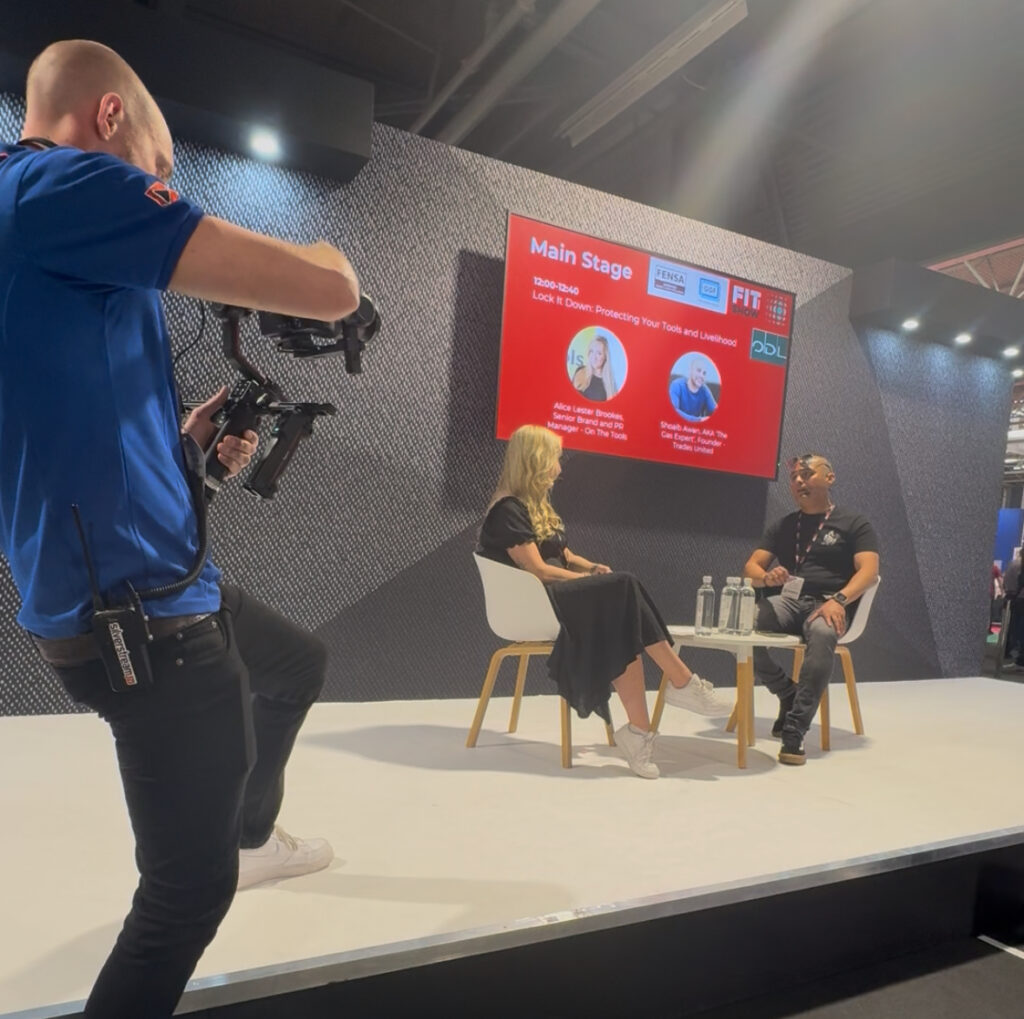
Inspired by a powerful panel at FIT Show 2025, Lucy Ball, Marketing Lead at Balls2 Marketing, looks beyond the headlines and into the heart of a crisis that’s hitting tradespeople where it hurts.
Tool theft is more than a criminal inconvenience. For UK tradespeople, it’s a daily threat to their livelihoods, mental wellbeing and long-term careers. It’s also quietly undermining an industry already stretched by skills shortages, rising costs and mounting pressure to deliver on national infrastructure promises.
And yet, despite the scale of the issue, it remains one of the least effectively addressed crimes in the UK.
At FIT Show 2025, a standout seminar tackled this head-on. ‘Lock It Down: Protecting Your Tools’, led by Shoaib Awan, better known as The Gas Expert and founder of Trades United, alongside Alice Lester Brookes, Senior Brand & PR Manager at On The Tools, highlighted the harsh realities tradespeople face every day, from van break-ins to the emotional toll of repeat theft.
So, the question is this: if we’re serious about protecting the future of UK construction, why aren’t we doing more to protect the people on the ground?
A crime that hits harder than the statistics suggest
Tool theft is often discussed in financial terms, and yes, the cost of replacing stolen tools can run into the thousands. But the real impact goes deeper.
It’s the cancelled jobs. The weeks off work. The broken trust between business and client. It’s the feeling of being repeatedly targeted with no clear support.
According to research by On The Tools:
- 68% of tradespeople regularly worry about tool theft
- 98% say not enough is being done to address it
- Only 1% of stolen tools are ever recovered
When your tools are stolen, you lose more than your kit, you lose your ability to earn. And when it happens more than once, the emotional toll can be enough to make people walk away from the industry altogether.
A perfect storm: high reward, low risk
Criminals know what they’re doing. Tool theft is often organised, targeted, and incredibly efficient. Vans are broken into in minutes. Entire inventories disappear overnight. And thanks to unregulated resale environments like car boot sales and online marketplaces, there’s an easy, untraceable path to profit.
In 2023 alone:
- 46,500 thefts were reported in the UK
- Just 11 convictions followed
And that’s only the reported figures. Many thefts never make it onto police databases, either because the victim doesn’t bother reporting or because forces don’t log tool theft as a distinct crime.
Shoaib Awan put it bluntly during the session: “This is organised crime. We’re not dealing with one-off incidents. We’re dealing with patterns, and yet the system isn’t set up to track or respond to them.”
Why it matters for the future of UK construction
If we treat this as ‘just another problem’ for tradespeople to deal with, we’re missing the bigger picture.
The UK construction sector is already under pressure. We’re facing a labour shortfall, rising demand, and ambitious targets, including the government’s pledge to build 1.5 million homes in the next five years.
That goal depends on a thriving workforce of electricians, plumbers, joiners, builders, fitters, roofers – the very people losing thousands of pounds’ worth of tools every week.
In Shoaib’s words: “We are the backbone. We build everything. Repair everything. If we can’t work, the whole system slows down.”
What’s going wrong?
Several systemic issues were called out during the session. Inconsistent police reporting is a major barrier – many forces don’t categorise tool theft properly, making it almost impossible to identify patterns or allocate the right resources.
Then, there’s the lack of regulation around resale. It’s estimated there are more than 1,200 car boot sales operating across the UK. With little to no enforcement, stolen tools are changing hands with ease and without scrutiny.
Even when tools are recovered, ownership challenges mean they often sit unclaimed. Without clear records, serial numbers or forensic marking, millions of pounds’ worth of kit ends up locked in evidence rooms, never returned.
What needs to change?
This can’t be solved by tradespeople alone. It needs cross-sector coordination, from manufacturers and insurers to government bodies and local police forces.
There are tangible actions we can all take now, and they start with traceability. Forensic marking systems like SelectaDNA, registering tools online, logging serial numbers and keeping a photo inventory all make it easier to prove ownership and support recovery. Tools should be clearly labelled, documented, and as identifiable as possible.
Van security is another crucial line of defence. No lock is invincible, but visible deterrents can buy time and often persuade thieves to move on. Internal lockboxes and motion-triggered alarms offer another layer of protection, making it harder for criminals to get in and out quickly.
Reporting every theft, even when it feels futile, is essential. Without consistent data, there’s no foundation for reform. Every report adds weight to the argument that this issue can’t be ignored.
And finally, there’s the resale problem. If you spot stolen tools being flogged at a car boot sale or online, call it out. Raise it with Trading Standards. Share it on social media. The more visible we make the issue, the harder it becomes for thieves to operate in plain sight.
There is momentum, but we have to keep pushing
One of the more positive messages from the session was that things are starting to move. Tool theft is finally getting the airtime it deserves. Brands, platforms and industry figures are uniting to raise awareness, and more tradespeople are taking action to protect their kit and their businesses.
But it’s not enough to rely on small wins. We need sustained pressure, sector-wide action, and a shared commitment to defending the people who keep our homes, businesses and infrastructure running. It’s why we’re talking about it – not just to highlight the problem, but to begin the discussion on what we can do, as marketers and communicators, to help better educate and equip installers with the knowledge, tools and awareness to drive meaningful change.
















